Butternut Squash Mac and Cheese
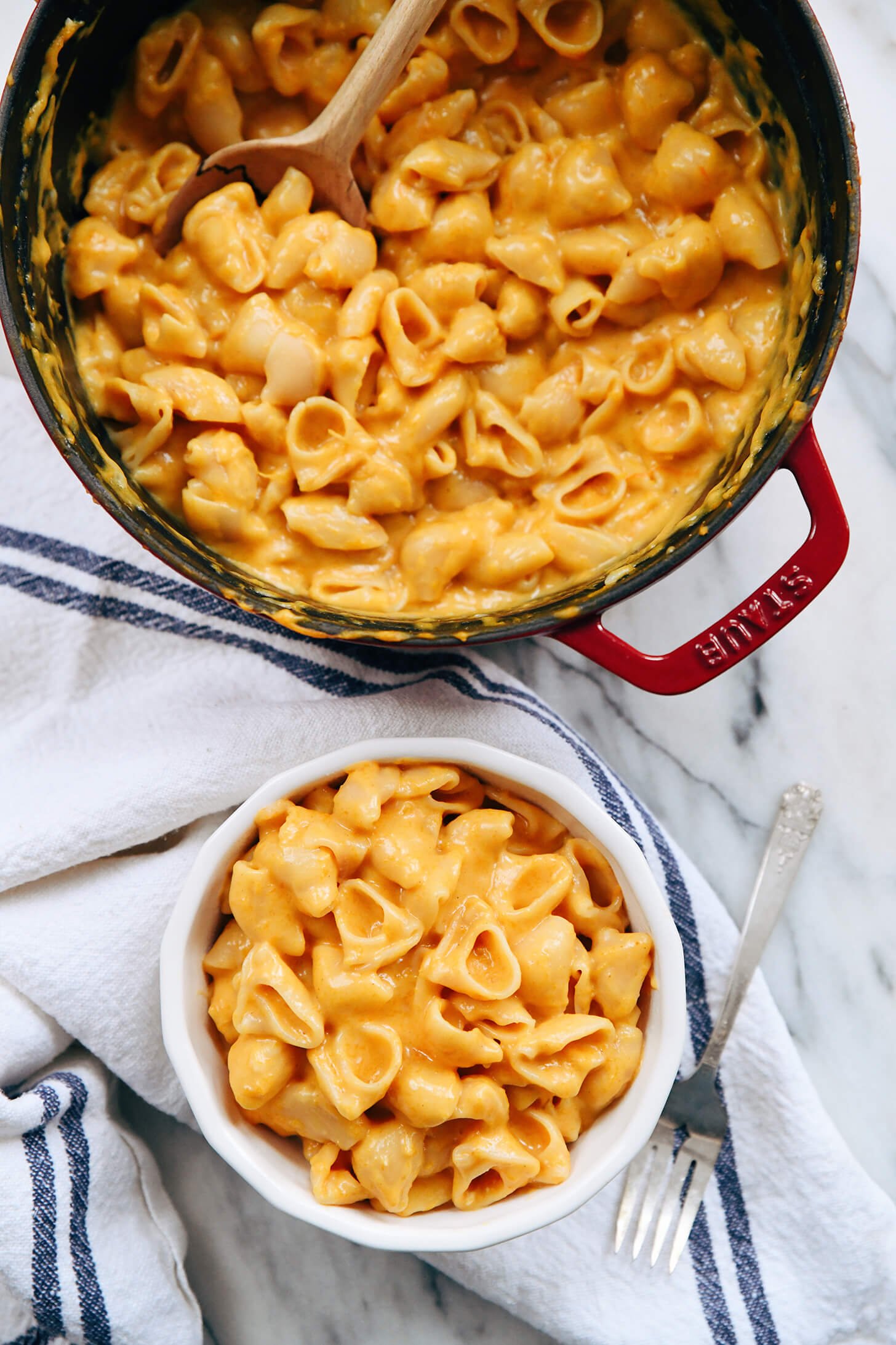
This butternut squash mac and cheese recipe strikes the perfect weeknight balance. It’s creamy, it’s cheesy, it’s comforting and completely delicious. This mac and cheese is not so rich that you’ll get a belly ache or fall asleep immediately after dinner.
This recipe is redeeming, too—it’s full of luscious roasted butternut squash, which amps up the golden hue without overwhelming the flavor. This mac and cheese is a real crowd pleaser. Our toddler loves it and so do we.
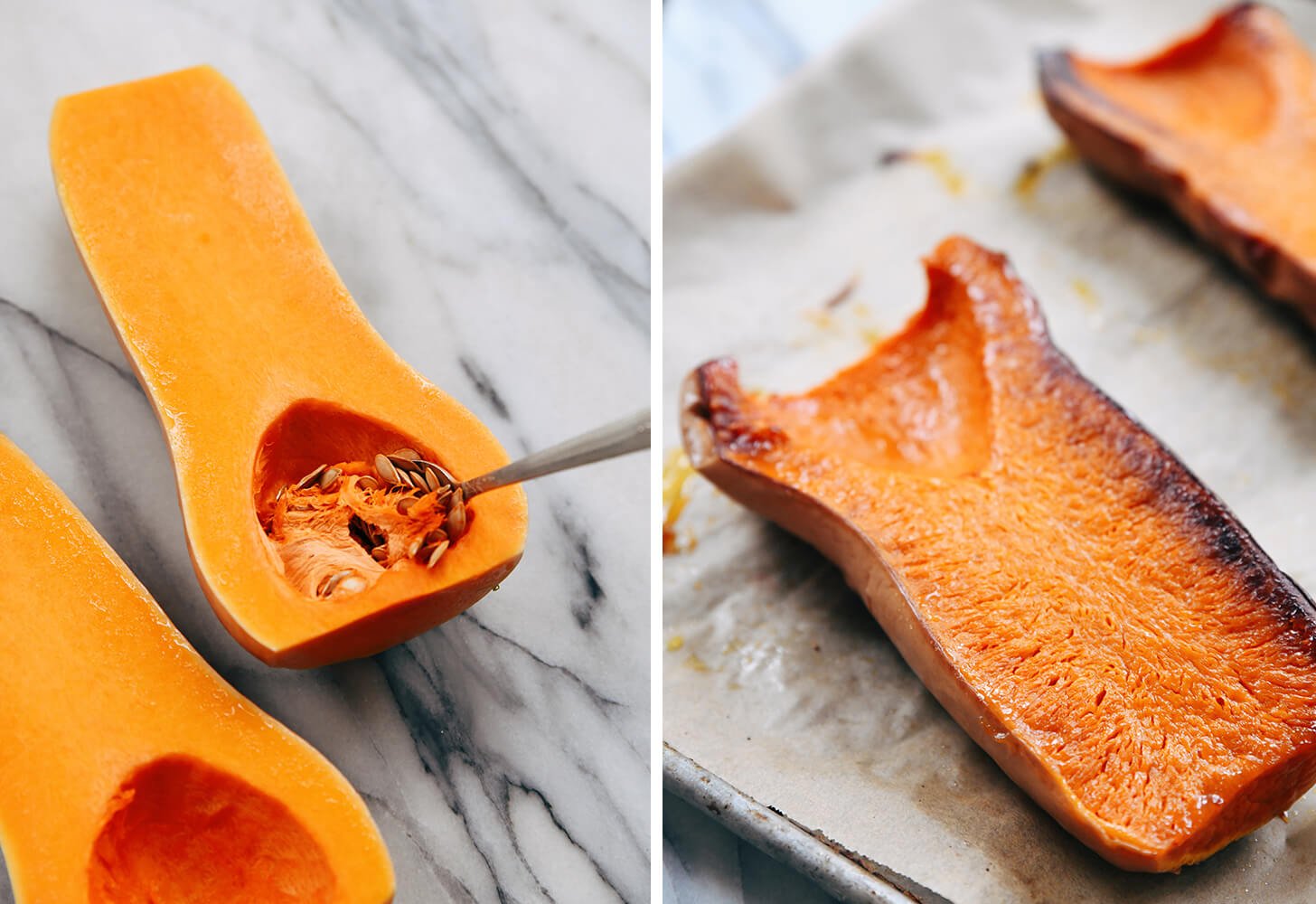
The cooking method is a thrill. This pasta comes together in one pot. You don’t ever strain the pasta. You don’t have to fuss with a béchamel sauce. You don’t have to get out the blender for the butternut.
If you roast your squash in advance, this recipe comes together in about 30 minutes. This is a unicorn of a pasta dish and I’m so excited to hear how it turns out in your kitchen.
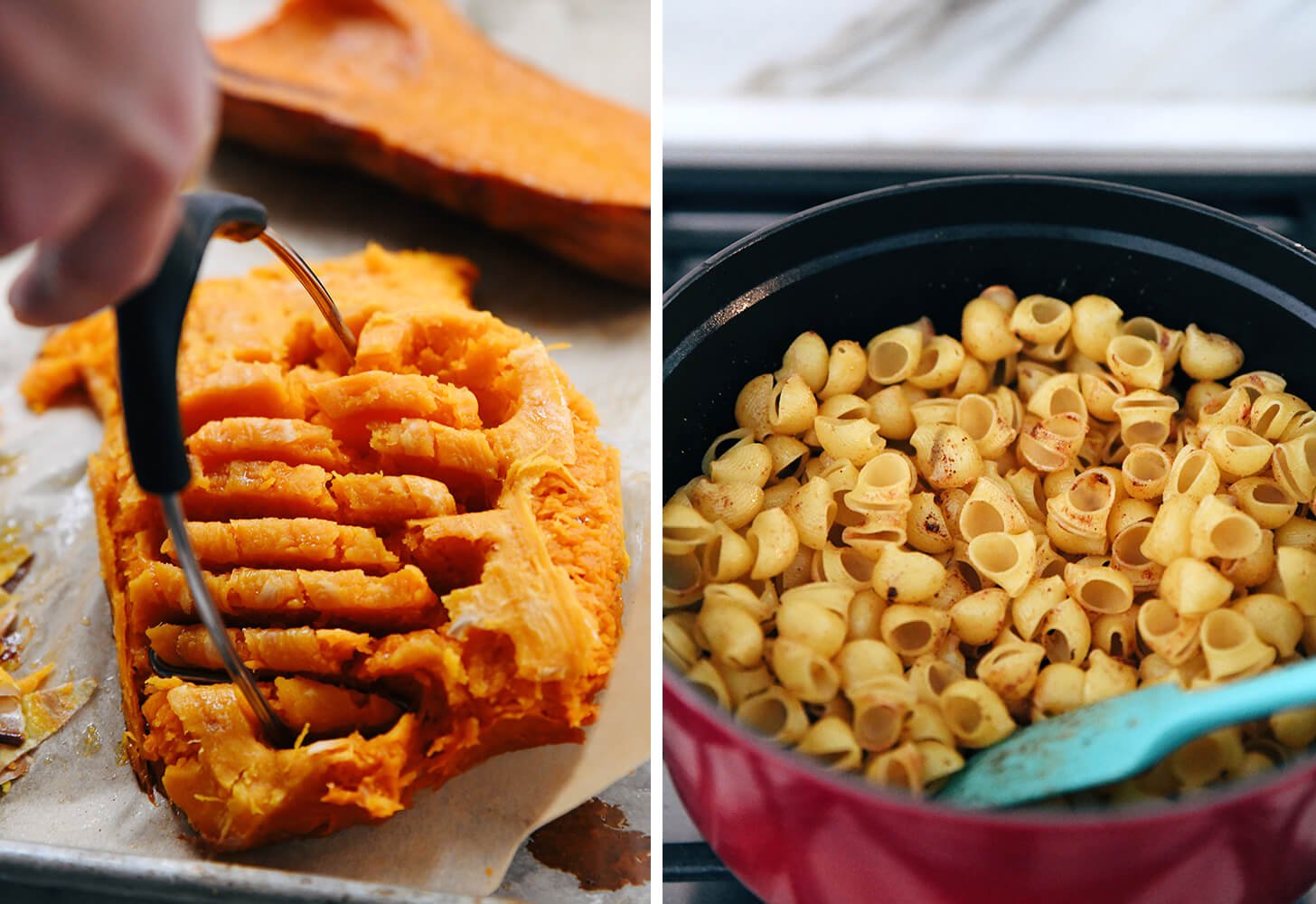
Butternut Mac and Cheese Ingredients
You’ll find the full recipe below. Here’s what you should know about the key ingredients before you head to the store.
Butternut Squash
Roast your squash in advance and this recipe comes together quickly. You can roast it a day before or earlier in the day—simply let it cool, then cover and refrigerate it for later.
Roast a large squash, and you’ll have twice as much squash as you need for this recipe. Freeze the other half for a future batch of mac and cheese! This recipe is flexible—use anywhere from one to two cups of mashed butternut squash per batch. (The recipe specifies two cups for max veggie power, but you certainly can use less.)
We’ll simply cut the squash in half and roast it until tender. Then peel off the skin, mash up the squash that you need, and drop it into the boiling water. Any little lumps will work themselves out while the pasta cooks. It’s like magic.
In a hurry? You can use one 15-ounce can of puréed butternut squash in place of the roasted squash. If you have a leftover can of pumpkin purée (not pie filling), that would work, too.
Short-Cut Pasta
Again, this recipe is flexible and I’ve used a variety of pasta noodle shapes with success. My favorite, which you’ll see in the photos, is pipe rigate. Other options include macaroni noodles, casarecce, cavatelli, fusilli, and the like. To make this recipe gluten free, we successfully used Jovial brand’s brown rice-based fusilli.
Tip: “Short-cut” pasta refers to compact noodle shapes, as opposed to long strands like spaghetti.
Cream Cheese
No béchamel required for this mac and cheese. Cream cheese stirs right into the pot and makes this pasta creamy, lightly tangy, and luxurious. You’ll use half of a standard block of cream cheese for this recipe, and I don’t know about you, but I’m always glad to have some extra cream cheese on hand for my toast.
Cheddar Cheese and Parmesan
Use a flavorful cheddar cheese for this mac and cheese. My favorite is Kerrygold, which annoyingly comes in a 7-ounce package rather than an even 8-ounce, but 7 ounces will do!
Parmesan cheese further amps up the flavor. Dust your individual servings with a little more Parmesan, if you’d like.
Tip: Grate your own cheese rather than buying pre-shredded cheese. Pre-shredded cheese is coated in powder that can cause the cheese to clump when it melts.
A Few More Basic Ingredients
You’ll also need olive oil (for roasting the squash), butter, garlic and onion powder, water and salt. Easy enough.
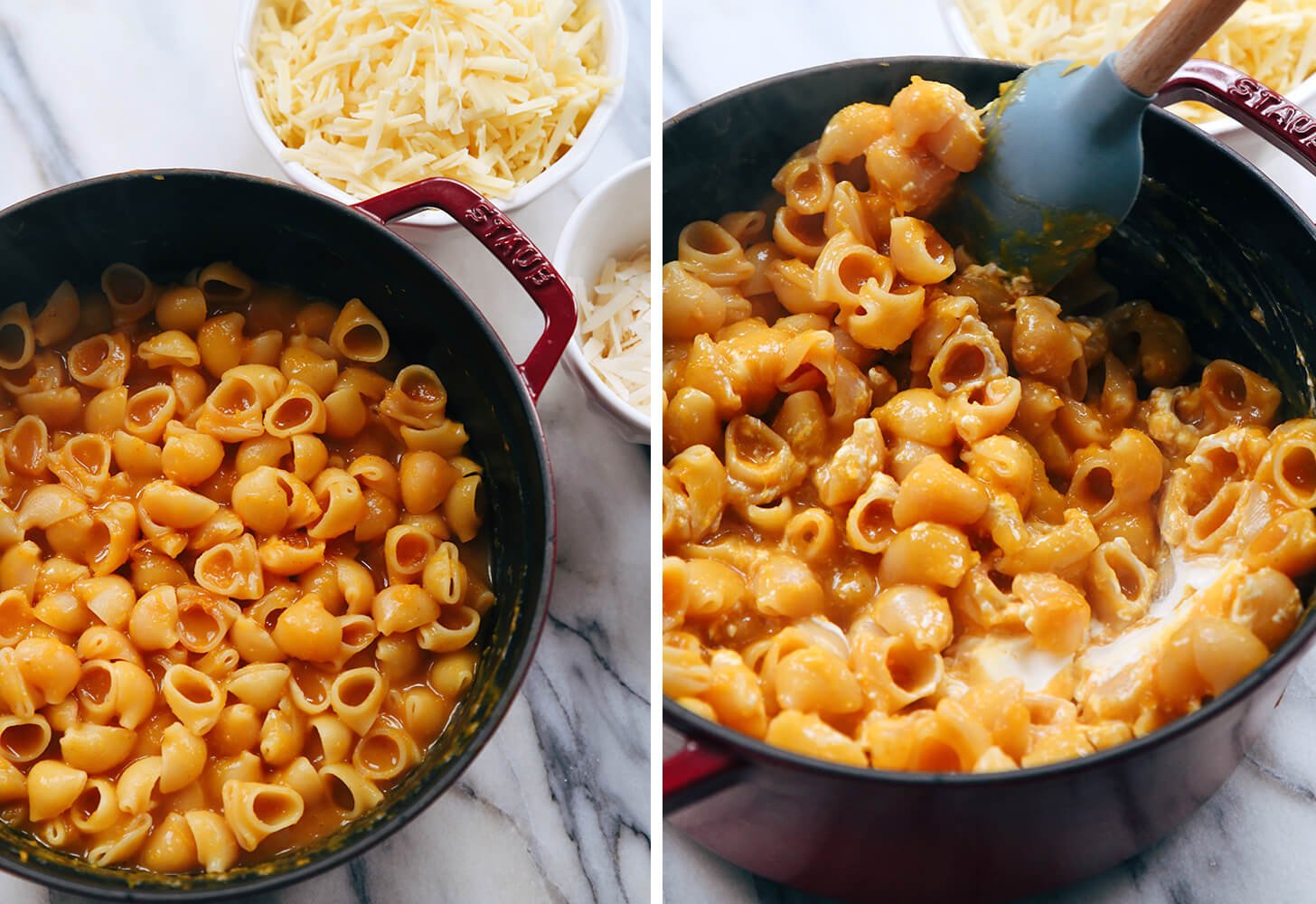
How to Safely Slice Your Butternut Squash
Butternut squash is large and dense, so it can be difficult to manage. Here are some tips on how to prepare it safely:
- Start with a sharp chef’s knife and a stable cutting board. You can place a lightly damp tea towel beneath your cutting board to keep it from moving around.
- Use the knife to cut off the tip-top and very bottom ends of the squash.
- Stand the squash upright with the thickest flat side as the base.
- Carefully slice through the squash from top to bottom to divide it in half. Your fingers should never be in the blade’s way.
- Lastly, use a large spoon to scoop out the seeds and discard them (we won’t need them for this recipe).
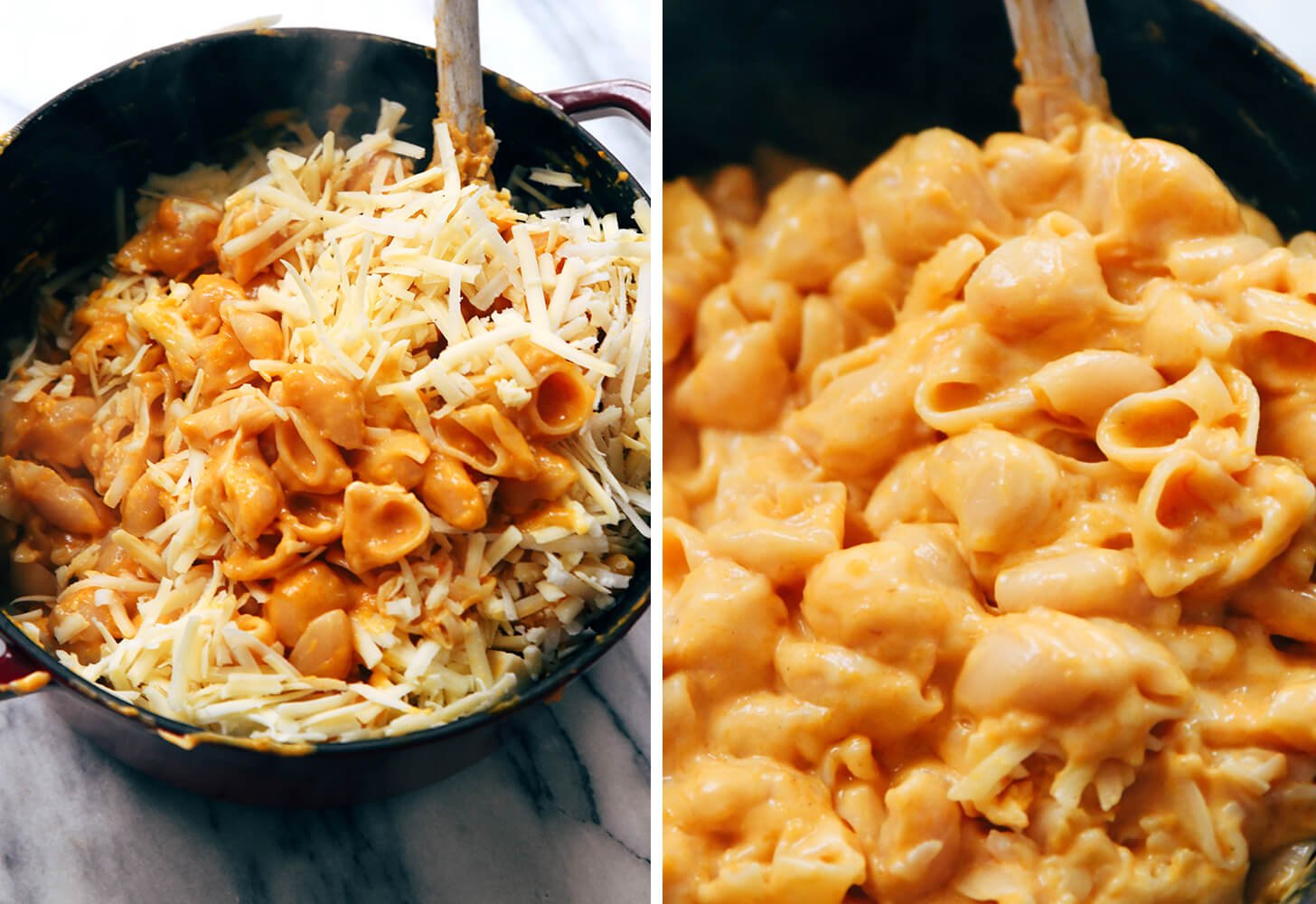
Serving Suggestions
Serve green salad on the side—perhaps my Super Simple Arugula Salad, Favorite Green Salad with Apples, Cranberries and Pepitas, or any improvised salad with a simple vinaigrette.
This recipe yields quite a lot of pasta (eight servings). It reheats well for packed lunches and leftover dinners. While I haven’t tried, I believe you could cut the recipe in half and cook it in a medium-sized pot.
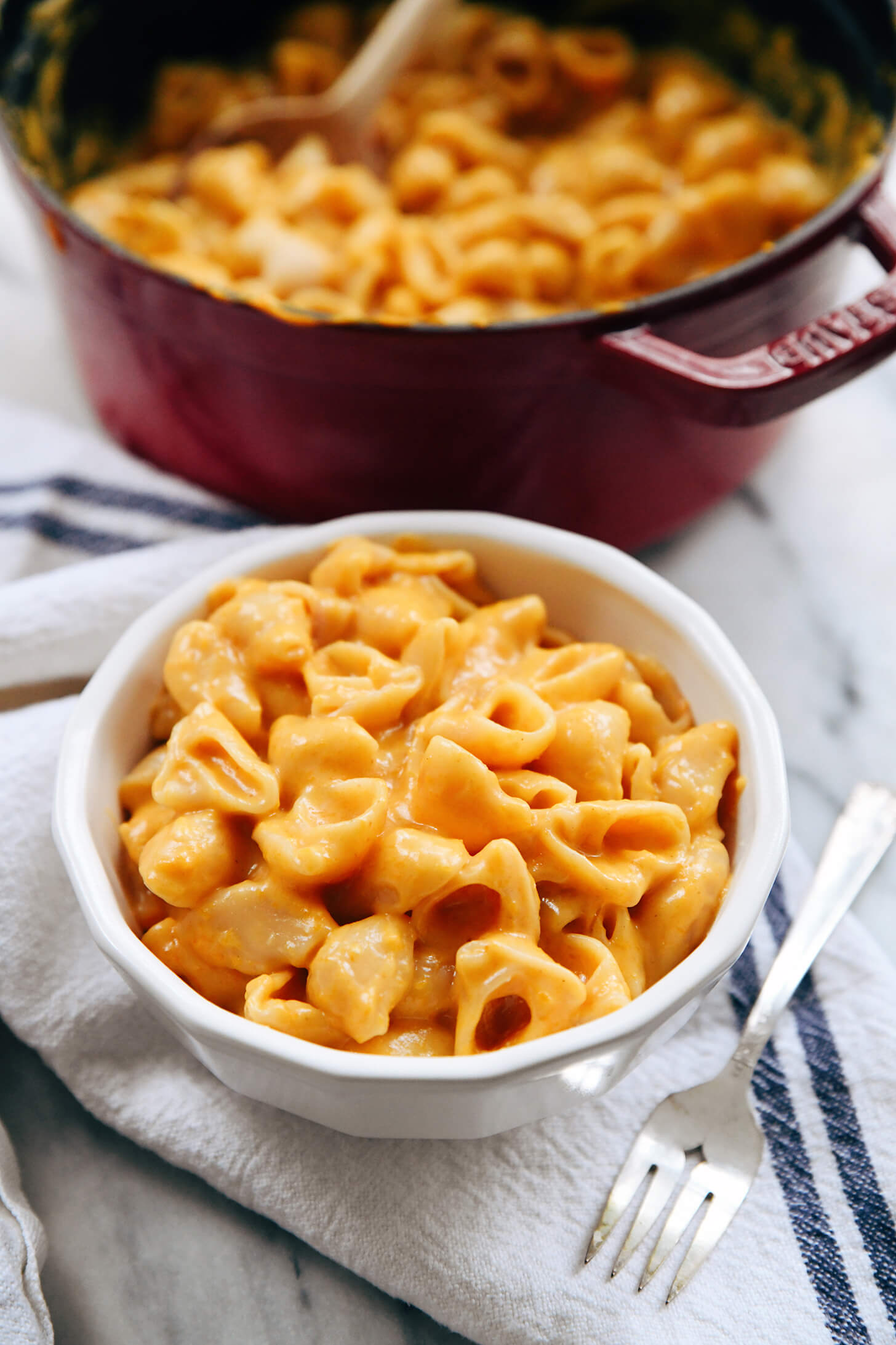
Love this butternut mac and cheese?
You’ll also enjoy these recipes on Cookie and Kate:
- Amazing Vegan Mac and Cheese
- Roasted Butternut Squash Risotto
- Roasted Butternut Squash Soup
- Roasted Butternut Squash Tacos
- Real Stovetop Mac and Cheese
Please let me know how your butternut mac and cheese turns out in the comments! This is the first one-pot pasta dish of this nature on the blog, and it certainly won’t be the last.

Print
Butternut Squash Mac and Cheese
- Author:
- Prep Time: 15 minutes
- Cook Time: 1 hour
- Total Time: 1 hour 15 minutes
- Yield: 8 servings 1x
- Category: Pasta
- Method: Stovetop
- Cuisine: American
- Diet: Vegetarian
This butternut squash mac and cheese is a delight! It’s just right—cheesy and creamy but not too rich, with subtle roasted butternut squash flavor. To help this recipe come together quickly for a weeknight dinner, roast the squash in advance. If you choose a large squash, you’ll have about twice as much as you need—freeze it for future use. Recipe yields 8 servings (quite a lot!) and leftovers are great.
Scale
Ingredients
- 1 medium to large butternut squash (1.5 pounds or larger), halved
- 1 teaspoon extra virgin olive oil
- 2 tablespoons unsalted butter
- 1 teaspoon garlic powder
- 1 teaspoon onion powder
- 1 pound short-cut pasta (pipe regate, macaroni noodles, casarecce, cavatelli, fusilli)
- 5 cups water
- 1 teaspoon fine salt, to taste
- 4 ounces cream cheese, cubed
- 8 ounces shredded sharp cheddar cheese
- ½ cup (2 ounces) finely grated Parmesan cheese, plus more for serving
Instructions
- To roast the squash: Preheat the oven to 425 degrees Fahrenheit. Line a large, rimmed baking sheet with parchment paper for easy clean-up. Scoop out the squash seeds with a spoon (we won’t need them for this recipe). Rub the olive oil over the cut sides of butternut, then place them on the prepared pan, flat sides down.
- Bake until the squash flesh is easily pierced through with a fork, about 40 to 60 minutes. Once it’s cool enough to handle, peel off the skin and discard it. Use a potato masher to mash up the squash—don’t worry about getting it perfectly smooth. You’ll need about 2 cups mashed squash for this recipe (you’ll likely have plenty extra, which you can freeze for future mac and cheese). Set aside, refrigerate and/or freeze the squash until ready to use.
- To prepare the mac and cheese: Melt the butter in a large pot or Dutch oven over medium heat. Add the garlic and onion powder and cook for 2 to 4 minutes, stirring often, until the butter is fragrant and you see little brown flecks forming in the pan. Add the dry pasta and gently toss to coat it in butter.
- Pour in the water and salt. Add 2 cups of the mashed butternut squash. Cover the pot and bring it to a boil over high heat. Once boiling, remove the lid and set the timer for 8 minutes.
- Cook, stirring occasionally, until the timer goes off. Do not drain the water. Stir in the cream cheese. Cook until the cream cheese has melted and the pasta is al dente (careful when you taste, it’s quite hot), about 4 to 5 more minutes. Turn down the heat as necessary to avoid scorching but maintain a steady simmer.
- Reduce the heat to low. Add the cheddar and Parmesan, and stir until the mixture is melted and creamy. Remove the pot from the heat.
- Season with salt, to taste (I usually add ¼ teaspoon more). Serve the pasta in bowls with extra Parmesan grated on top, if desired. Leftovers keep well, covered and refrigerated, for up to 5 days.
Notes
Make it gluten free: Gluten-free pastas vary widely. Choose a spiral-shaped gluten-free brown rice pasta, such as fusilli, over other pasta types (my tester was pleased with Jovial brand). Stir gently and don’t cook the pasta any longer than necessary or it may start to lose its shape.
▸ Nutrition Information
